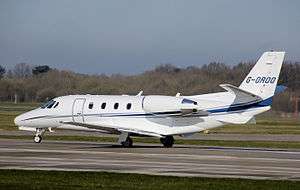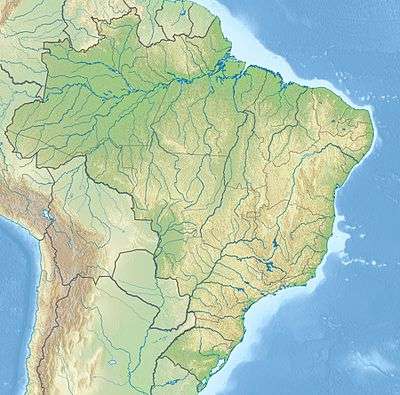2014 Santos Cessna Citation accident
 A Cessna Citation 560 XLS+ similar to the accident aircraft | |
| Accident | |
|---|---|
| Date | August 13, 2014 |
| Summary | Pilot disorientation |
| Site | Santos, São Paulo, Brazil |
| Aircraft | |
| Aircraft type | Cessna Citation 560 XLS+ |
| Operator | Af Andrade Enterprises and Holdings Ltd |
| Registration | PR-AFA |
| Flight origin | Brasilia International Airport, Brasilia |
| 1st stopover | Santos Dumont Airport, Rio de Janeiro |
| Destination | Santos Air Force Base, Guarujá |
| Passengers | 5 |
| Crew | 2 |
| Fatalities | 7 |
| Injuries | 11 on the ground |
| Survivors | 0 |
On 13 August 2014 a Cessna Citation 560 XLS+ crashed while carrying Brazilian Socialist Party presidential candidate Eduardo Campos. All seven people aboard the airplane were killed in the accident, which took place around 10 AM BRT while trying to land at Santos Air Force Base, near the city of Santos, São Paulo.[1] The pilot, co-pilot, a reporter, a photographer and two of Mr. Campos' campaign aides were among the dead.[2]
Crash
The 560XLS+ business jet took off from Santos Dumont Airport, Rio de Janeiro en route to Santos Air Force Base. Due to bad weather conditions at the destination the first landing attempt was abandoned, and contact was lost at 9:23 am local time. Around 10:00 am, the aircraft crashed into two houses and a gymnasium named Mahatma in Santos, breaking through the walls of several homes. Witnesses reported that the plane was on fire for a few minutes before the accident and tried to dodge the buildings.[3][4]

Investigation
Brazil's Aeronautical Accidents Investigation and Prevention Center performed the investigation into the accident. The report identified several factors that contributed to the accident.
Despite an annual maintenance inspection on 14 February 2014 which found that all maintenance was up-to-date, the aircraft's cockpit voice recorder had been inoperable since January 2013.[5]:140 By law, the aircraft could only fly without a functioning CVR if maintenance on it was scheduled within 15 days, or 30 in exceptional circumstances.[5]:140 The final report on the accident noted that the pilots' schedule complied with legal duty time and rest requirements, but that "expert examination of voice, speech and language parameters on the day of the accident...indicated...fatigue and somnolence on the part of the copilot in his communications with the ATS units."[5]:141
The conditions at Santos Dumont Airport had deteriorated since the last meteorological report the pilots had received. The ceiling was 300 feet (91 m) below the safe ceiling for a circle-to-land approach, but allowed an approach using the ECHO 1 route.[5]:143 Despite informing air traffic control that they would use the ECHO 1 approach to Runway 35, the aircraft was far to the right of the ECHO 1 approach. After reviewing other approaches the captain had made using the flight management system on visual approaches, the investigators hypothesized that the captain was using a visual approach, aided by the FMS, with the intention of joining the ECHO 1 trajectory on final approach. The report notes that the captain used a similar approach in previous landings and that "it is possible that the captain’s experience of landing in runways of other countries with precarious infrastructure conditions, in addition to his mistaken assumption of the real meteorological conditions in the aerodrome, may have contributed to his feeling safe upon adopting such procedure."[5]:144 However, such an approach, which saved five minutes, was not permissible in the meteorological conditions at the time of the crash, when aircraft could only use instrument only (IFR) approaches.[5]:144
The reason for abandoning the approach is unknown. Since the meteorological conditions were close to the minimum permitted for an IFR approach, the aircraft would need to approach close to the ECHO 1 approach trajectory. On the aircraft's improper approach, the investigation noted that there was a low probability that the aircraft could have stabilized its approach in order to land safely.[5]:146 With a wet runway and if the aircraft crossed the threshold at the reference speed, the aircraft would have a 385-metre (1,263 ft) safety margin to land on the wet runway. There was a 2 kn (3.7 km/h) tailwind at the time of the attempted landing. Additionally, a non-directional radio beacon (NDB) just before the runway (RR NBD) was non-functional on the day of the accident. Because the aircraft did not follow the ECHO 1 approach, it did not pass the only NBD available for determining the missed approach point, which was SAT NBD. The report concluded that "the fact that the crew did not follow the profile of the ECHO 1 [approach], along with their difficulty stabilizing the aircraft on a final approach, and the tail wind component condition may have contributed to their decision to discontinue the approach."[5]:147
The proper missed approach procedure was to make a left turn at the missed approach point—the RR NBD, which was inoperable, or one minute and fifteen seconds past SAT NBD, which the aircraft didn't cross—and climb to 4,000 feet (1,200 m). However, the pilots made a low pass over the runway and began a gentle left turn at the end of the runway. Witnesses state that the aircraft made a low pass over the port before disappearing into the clouds.[5]:147 On this trajectory, the aircraft made a "tight" turn, with a bank angle up to 60° and g-force up to 2.0 G.[5]:148 The investigation hypothesized that the pilots were flying manually, therefore leading to a large workload for the pilot-in-command. The missed approach procedure required a significant amount of work that had to be performed in a short time. Investigators noted that "[t]he captain’s personal characteristics, indicating a person with a more impositive and confident posture, in opposition to the more passive posture of the copilot, in addition to the more limited knowledge of the equipment on the part of the latter and the possibility that he (the copilot) was fatigued, may also have hindered the dynamics of the crew in the management of the flight."[5]:148 Investigators believe the combination of the meteorological conditions, the effect of the high g-forces on the pilots' sense of spatial perception, and that the pilot-in-command would have been rapidly switching his focus between the instrument panel and exterior caused "incapacitating" spatial disorientation, which led to an "abnormal attitude."[5]:148
The aircraft did not respond to multiple calls from air traffic control after initiating the missed approach, suggesting the pilots were under a heavy workload managing the aircraft. Two images of the aircraft from different cameras moments before the crash show the aircraft at 35° (± 5°) and 22.4° dive angles.[5]:149–50 The report notes that "the aircraft could only have reached such speed and fly that trajectory[] if it had climbed considerably"[5]:149 after entering the clouds and that, in normal conditions, the pilots would not have deliberately placed the aircraft in such a steep dive.[5]:149
Of fracture surfaces examined, none showed signs of fatigue but were caused by stress overload at the moment of impact. There was no abnormality with engine function in the moments before the crash and no evidence of failure of any aircraft system.[5]:150
Aftermath
All seven people on board the aircraft were killed, including the former governor of the state of Pernambuco and presidential candidate in the 2014 Brazilian general election on October 5, Eduardo Campos; Pedro Almeida Valadares Neto, political adviser and a former congressman from Sergipe; adviser Carlos Augusto Ramos Leal Filho (known as Carlos Percol); campaign photographer Alexandre Severo Gomes da Silva; campaign cameraman Marcelo de Oliveira Lira; and two pilots, Marcos Martins and Geraldo Cunha.[6] Identification of the remains was carried out through the study of the DNA.[7] The Cockpit Voice Recorder did not record any of the conversations during the flight before it crashed.[8] Unlike bigger airplanes, the Cessna was not required by regulations to have a Flight Data Recorder.[9]
Residents of the local houses were taken to hospital with injuries, one was released immediately, and five others were admitted with minor injuries: two children aged 1 and 9, three women, one of whom is elderly.
See also
- Armavia Flight 967 - nose-down controlled flight into terrain shortly after an aborted approach
- Flydubai Flight 981 - nose-down controlled flight into terrain during an aborted approach
- List of fatalities from aviation accidents - list of notable persons killed in aircraft crashes
References
- ↑ "Brazilian Presidential Candidate Killed In Citation Crash | Aviation International News". Ainonline.com. 2014-08-13. Retrieved 2014-08-26.
- ↑ Lyons, John (2014-08-13). "Brazilian Presidential Candidate Eduardo Campos Dies in Plane Crash - WSJ". Online.wsj.com. Retrieved 2014-08-26.
- ↑ "8 people die after a plane crashed in Brazil". BBC News. 13 August 2014. Retrieved 13 August 2014.
- ↑ "ASN Aircraft Accident for Cessna 560XLS+ Citation Excel Guarujá". Aviation Safety Network. Retrieved 2014-08-18.
- 1 2 3 4 5 6 7 8 9 10 11 12 13 14 15 16 Final Report: A-134/CENIPA/2014 (PDF) (Report). Aeronautical Accidents Investigation and Prevention Center. February 2016. A-134/CENIPA/2014.
- ↑ "Expectativa é de que enterro de Campos seja no domingo". Diario de Pernambuco (in Portuguese) (14 August 2014). Recife. Retrieved 8 September 2014.
- ↑ "Corpos de Eduardo Campos e de equipe passarão por exame de DNA". Diario de Pernambuco (in Portuguese). Recife. 13 August 2014. Archived from the original on 2014-08-18. Retrieved 9 September 2014.
- ↑ "Brazil crash: Black box 'did not record Campos flight'". BBC News. 15 August 2014. Retrieved 8 September 2014.
- ↑ Sorano, Vitor (August 15, 2014). "Caixa-preta não gravou diálogos do voo de Eduardo Campos, diz a Aeronáutica" [The black box didn't record speeches from Eduardo Campos's flight, Air Force says]. Tribuna da Bahia Online (in Portuguese). Retrieved September 30, 2014.